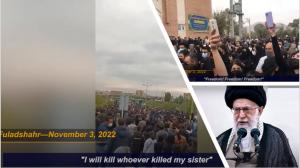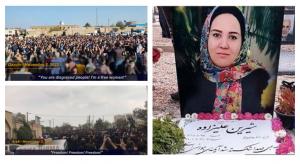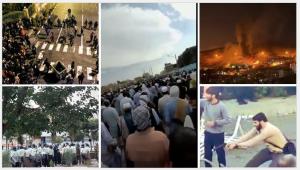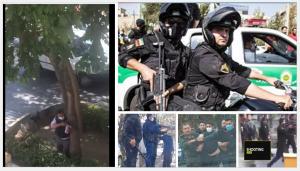(Video) The Continuation of Iran Protests Lays Bare Regime’s Weakness and Deadlock

Iran's uprising entered its 54th day on Monday. The first result of what protesters call a “revolution” is that the regime failed to control it. On Oct.12, Khamenei called the nationwide protests “minor incidents,” and said people “shouldn’t pay much attention to it."

The continuation of the protests forced Khamenei to express his utter fear of the Iranian people’s revolution. While trying to ignore the uprising, he labeled the protesters foreign agents, and called the people and their organized opposition as “enemies” of Iran.

The day after Khamenei’s speech, Iranians poured on the streets in many cities to honor the martyrs on their 40th day of martyrdom. In Karaj, Alborz province, people clashed with security forces & in dozen other cities, forced the oppressive forces to flee.
It is worth noting that Khamenei has been using his Revolutionary Guards (IRGC) and all other oppressive apparatus to control Iran’s volatile society somehow.
Regime officials made much fanfare about ending the uprising soon or threatened to quash protesters. Some authorities even went as far as claiming protests have finished it, leaving some “scattered sidelines” and “minor consequences” behind, that the regime would “wrap them up” quickly.
On October 12, the regime’s Supreme Leader Ali Khamenei called the nationwide protests “minor incidents,” saying that officials “shouldn’t pay much attention to it.”
But the uprising persisted despite the regime’s attempts to suppress it brutally. The continuity of protests forced Khamenei to express his utter fear of the Iranian people’s revolution. While trying to paint protesters as foreign agents and calling people and their organized opposition as “enemies,” Khamenei said: “What we witnessed in the last few weeks was not just a street riot. The enemy had more profound plans and started a combined war.”
The day after Khamenei’s speech, Iranians poured on the streets in many cities to honor some martyrs on their 40th day of martyrdom. In Karaj, Alborz province, people clashed with security forces and, like Iranians in dozen other cities, forced the oppressive forces to flee.
It is worth noting that Khamenei has been using his Revolutionary Guards (IRGC) and all other oppressive apparatus to control Iran’s volatile society somehow.
The continuation of the current uprising has forced authorities to acknowledge their miserable failure in suppressing protests. “The system is not lost, but we have received a heavy blow,” the state-run Khabaronline website quoted IRGC Brigadier General Rasoul Sanai-Rad, as saying on November 6.
Sanai-Rad is Khamenei’s advisor and political deputy of the army’s Ideological−Political Organization, a highly influential military apparatus, and his remarks reflect Khamenei’s deadlock vis-à-vis the uprising.
Khamenei and his ilk have tested all plots and forms of violence and crime to quash the uprising in the last 53days. From attacking prisoners in the notorious Evin prison and setting it on fire to two massacres of innocent worshipers in Sistan and Baluchistan province, attacking Tehran’s Sharif University, and opening fire on innocent protesters, killing over 550 Iranians, including dozens of children.
The regime’s last failed attempt to counter the ongoing uprising was holding state-staged protests on November 4. Yet, these counter-protests, with their very few and scattered participants, laid bare the regime’s weakness.
On November 6, some 200 MPs issued a statement calling for the “execution and punishment” of protesters. On November 7, Mohseni Ejei, the regime’s judiciary chief, showed his teeth, threatening protesters with capital punishment.
“Those who committed crimes during the recent riots should be rapidly identified and arrested. The judiciary officials should quickly act to condemn and punish the rioters,” he said, as quoted by the state-run Keyhan daily, known as Khamenei’s mouthpiece.
But, as the uprising continues to endure despite the violent crackdown, the regime’s infightings exacerbate, increasing the cracks in the mullahs’ fragile grip on power.
“Defendant has rights, including free access to a lawyer and informing their family members. Violating their rights is not for our benefit. Because soon, those [officials] who are now out of prison might be accused and arrested,” MP Jalil Rahimi Jahan-Abadi told the state-run Jahan-e Sanat daily on November 7.
For Khamenei is crystal clear that killing more protesters further inflames the uprising and increases his regime’s infightings. In a nutshell, Khamenei is in a deadlock.
Iranian men and women’s bravery has been applauded by the world community. But this is not enough. The Iranian people are ready to achieve their freedom at any cost, so the international community should support their aspirations.
The first and foremost practical way to support the current “revolution” is to recognize the protesters’ right to self-defense. This would not only prevent the regime from increasing its crimes, but it would also accelerate the mullahs’ downfall.
“I am not afraid of loud cries on the streets. But I am afraid of the theory of ‘self-defense’ and people fighting back,” Ali Rabie, Hassan Rouhani’s minister of labor and an infamous torturer said in this regard on October 29, as quoted by the state-run Etemad daily.
Shahin Gobadi
NCRI
+33 6 61 65 32 31
email us here
November 3, 2022: Protests in Fasa, Bandar Anzali, Baneh, Arak, Bijar, Tabriz, Shiraz, Fuladshahr, Qazvin, Marivan, Mashhad, Chalus, Kerman, and Kermanshah.
Legal Disclaimer:
EIN Presswire provides this news content "as is" without warranty of any kind. We do not accept any responsibility or liability for the accuracy, content, images, videos, licenses, completeness, legality, or reliability of the information contained in this article. If you have any complaints or copyright issues related to this article, kindly contact the author above.


